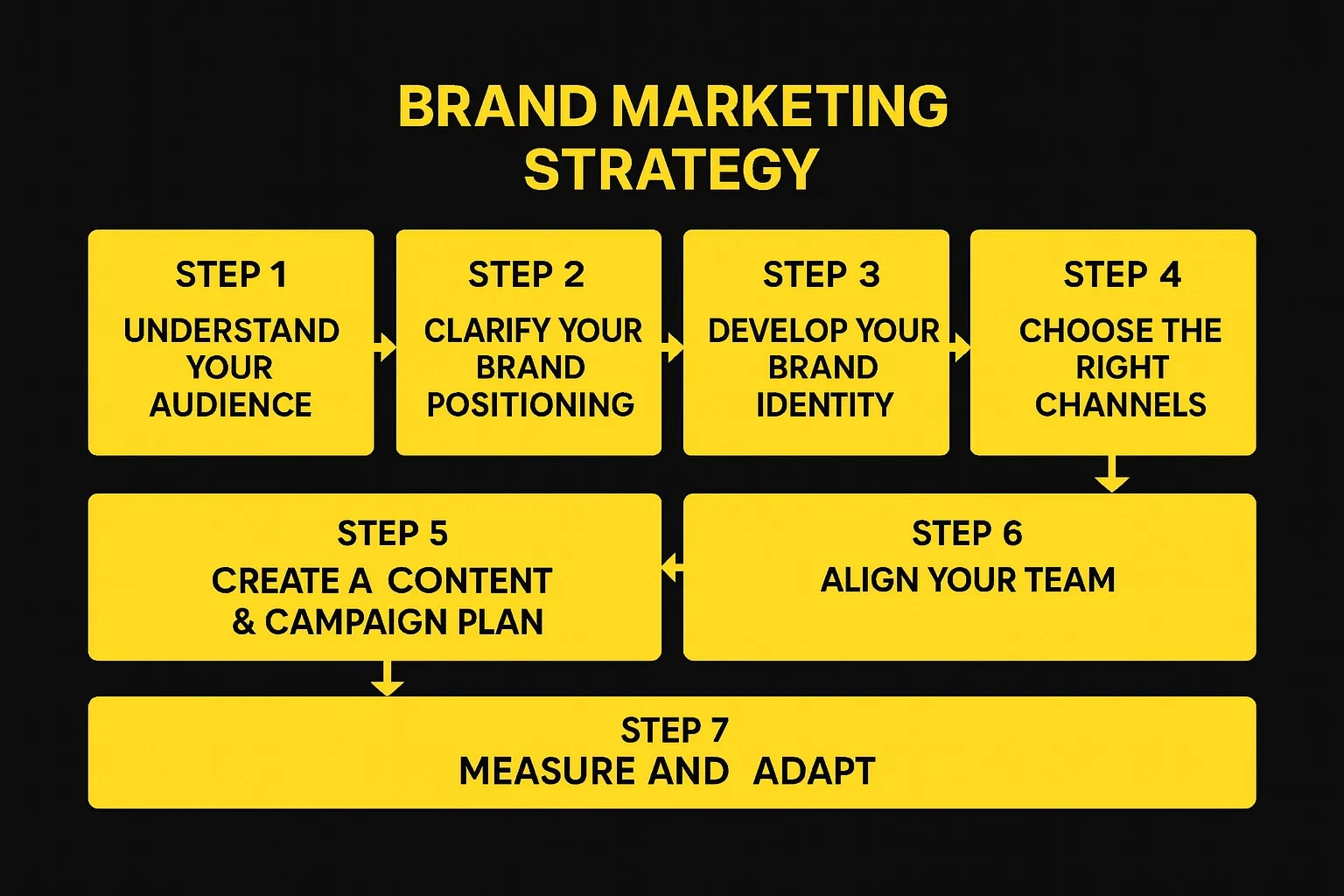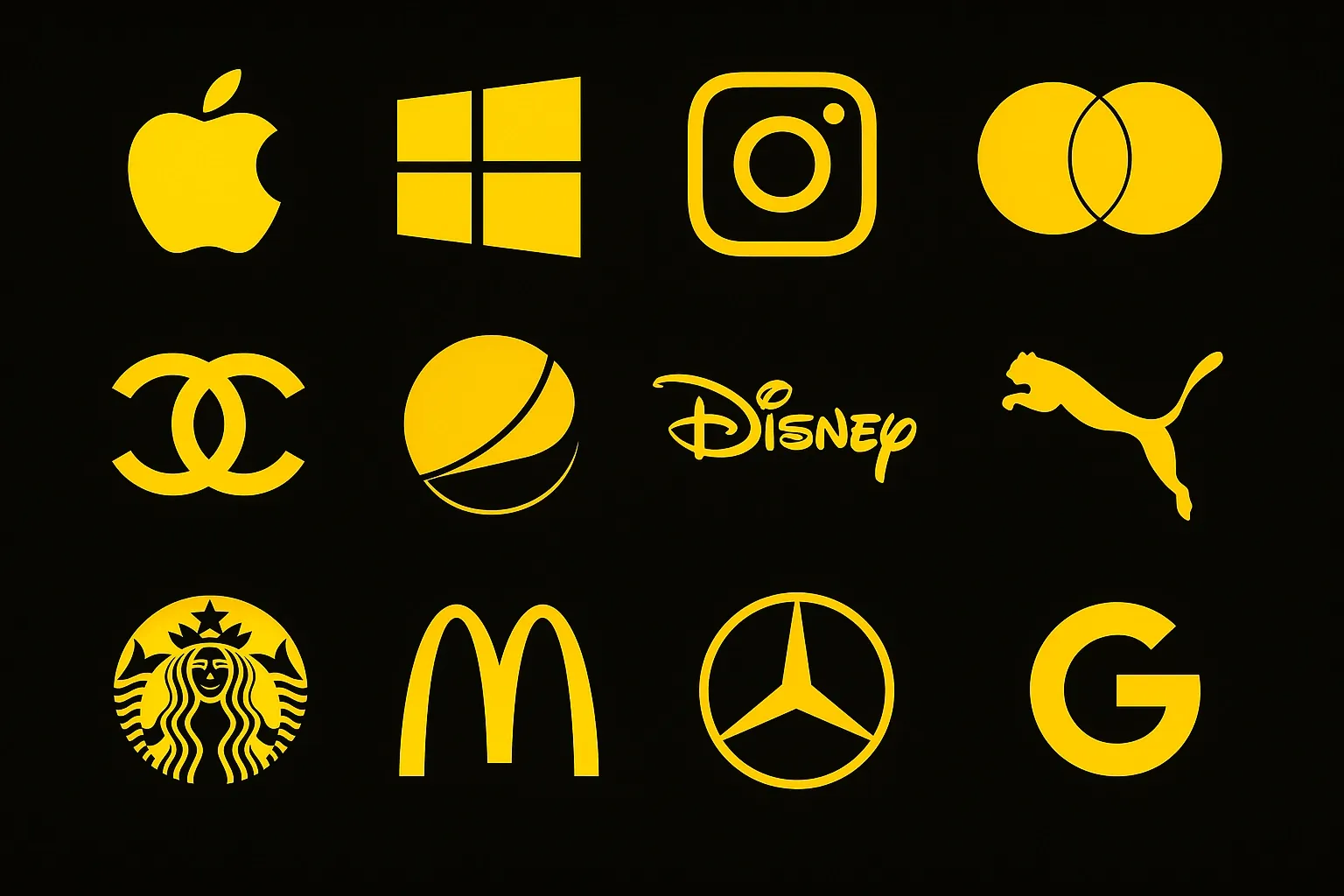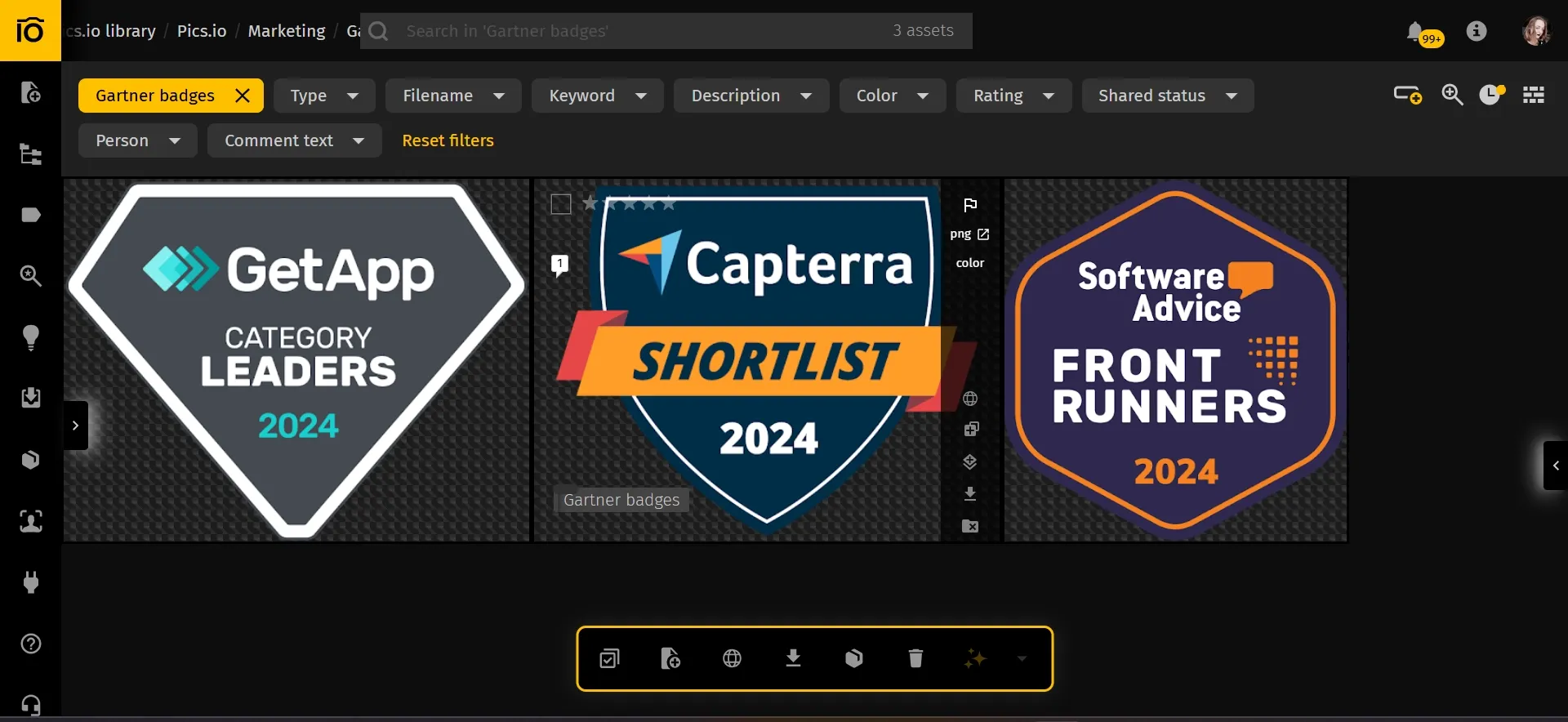Contents:
I’ve heard about the importance of branding since my university days. It was one of those concepts everyone kept repeating like a mantra—“Your brand is everything,” “Strong brands win hearts,” “Branding builds loyalty.” And honestly, it sounded simple and obvious enough at the time.
But once I started working in real marketing teams—building campaigns, creating content, launching products—I began to realize how not simple it actually was. What does “a good brand” even mean in practice? How do you build one from scratch? What makes a brand memorable, trusted, or loved? And how can a company—whether it’s a startup, a growing business, or even a personal brand—make branding actually work, not just sound nice on paper?
That’s where brand marketing comes in. It’s the bridge between “we want to be known for something” and actually being known, respected, and recognized for it. And none of this works without a strategy. A real, clear, long-term branding and marketing strategy—not just sporadic social posts and a pretty logo.
That’s why I decided to write this post. After more than a decade working in different marketing roles, I’ve seen what happens when branding is done well—and what happens when it’s not. So in this article, I’ll walk you through what brand marketing really means, who needs it, what it can do for your business, and how to build a strategy that actually works in the real world.
Let’s get into it.
Quick Takeaways on Your Brand Plan
- Brand marketing is about emotional connection, not just sales. It builds trust, loyalty, and recognition over time—not solely focusing on short-term conversions.
- Every organization benefits. Startups, B2B, nonprofits, personal brands—all gain from brand marketing by standing out, building trust, and aligning teams.
- Clear goals power strategy. Key aims include raising awareness, forging emotional links, earning credibility, differentiating from competitors, and fueling long-term growth.
- Strategy is structured and actionable. A solid brand marketing strategy consists of steps: audience insight, positioning, identity (visual/verbal), channel selection, content planning, internal alignment, and iterative measurement.
- Consistency across touchpoints builds equity. From visuals and tone to experiences, consistency helps people instantly recognize and trust your brand.
- Tactics support the roadmap. Examples include cohesive visuals, authentic brand voice, story-driven content, emotional campaigns, social proof, unified customer interactions, and long-term brand-building initiatives.
- Measuring impact goes beyond immediate KPIs. Track brand health via awareness, recall, sentiment, engagement, loyalty, and long-term indicators like revenue, conversion efficiency, and customer lifetime value.
- Tools like DAM streamline execution. Digital Asset Management (DAM) systems ensure brand consistency, faster production, rights control, global alignment, and data-driven decisions.
Brand Marketing Strategy Impact With Examples
| Sales & ROI | Brand marketing outperforms performance marketing in 80% of cases | Apple, Nike |
| Overall ROI from Balanced Strategy | Brand + performance mix boosts ROI by 25–100% | Coca-Cola, Airbnb |
| Revenue Growth | Businesses with brand strategy see +10–20% revenue growth | Salesforce, HubSpot |
| Revenue Boost via Consistency | Consistent brand presentation can increase revenue by 20–23% | McDonald's, Spotify |
| Consumer Trust & Preference | 81% need to trust a brand before buying; 59% prefer known brands | Amazon, Patagonia |
| Retention Value | 10% increase in retention = 30% increase in company value | Netflix, Starbucks |
| Emotional Bonding & Loyalty | Emotional connection can increase customer LTV by 306% | Dove, Lego |
| Market Share Growth | 10% share of voice lead = ~1.5% annual market share gain | P&G, Unilever |
| Paid Search Driven by Brand | 30% of paid search traffic is driven by brand marketing | Zappos, Canva |
| Improved Conversion Rates | Established brands see higher conversion rates and lower acquisition cost | Zendesk, Shopify |
What Is Brand Marketing and Why It Matters?
For years, I thought of marketing mostly in terms of performance—clicks, leads, conversions. All the numbers you can track in a spreadsheet. And while those are important (believe me, I’ve spent hours knee-deep in campaign analytics), they don’t tell the whole story. Because what makes people click—or better yet, come back—isn’t just a clever ad or a limited-time offer. It’s the feeling they have about your brand.
Brand marketing is the side of marketing that deals with perception, identity, and trust. It’s not about selling a product once—it’s about making people remember who you are and why they should care. It’s about the emotional connection between your audience and your brand, and the long-term relationship you build with them.
Think about brands like Patagonia, Apple, or even small but bold companies you personally love. What made you loyal? Chances are, it wasn’t just the product specs. It was the message, the consistency, the way the brand speaks, shows up, and feels. That’s brand marketing in action.
And here’s why it matters:
In a world flooded with options and constant noise, your brand is your shortcut to being chosen. When people trust you, recognize you, and feel aligned with what you stand for—they’re more likely to buy from you, stay with you, and recommend you to others.
You can spend thousands pushing paid ads or boosting posts, but without a strong brand underneath, it’s like trying to build a house on sand. The numbers might rise for a moment—but they won’t hold.
Brand marketing gives your business a backbone. It shapes how you're perceived in the market, and it sets the tone for every campaign, every product launch, every customer interaction. It’s what turns marketing from a transaction into a conversation.
But here's the thing—brand marketing doesn't exist in isolation. It works best when supported by other strategic marketing efforts, including establishing your brand's credibility and authority through quality content and ethical practices like using a white hat link building service to earn trusted backlinks that reinforce your brand's reputation in the digital space.
Who Needs Brand Marketing?
When people hear “brand marketing,” they often think of huge corporations with multimillion-dollar budgets and slick Super Bowl ads. And yes, those companies absolutely rely on brand marketing—but they’re not the only ones who need it.
In my experience, every business, no matter its size or industry, needs some form of brand marketing. I’ve worked with early-stage startups, B2B software companies, NGOs, and even solopreneurs—and I’ve seen firsthand how important it is to build and protect a strong brand presence.
If you're a small business owner, brand marketing helps you stand out in a crowded market. If you're a growing SaaS company, your brand builds trust when your product is still evolving. If you're a personal brand—like a coach, consultant, or content creator—it’s literally you that people are buying into. The way you present yourself matters more than the size of your following.
And if you're in B2B, brand marketing isn’t just helpful—it’s critical. In long sales cycles where multiple decision-makers are involved, your brand becomes a signal of reliability. It tells potential clients that you’re not just another vendor—you’re a partner they can trust. Especially in competitive markets, a well-established brand can be the deciding factor between you and a lookalike competitor. It shortens the trust-building process and makes sales conversations warmer from the start.
Even inside bigger companies, I’ve noticed how internal teams benefit from consistent brand work. It aligns everyone—from product to support to sales—around the same story. And that’s powerful. When your team believes in the brand, it shows up in how they talk about it, how they sell it, and how they treat customers.
So, who needs brand marketing?
- Startups trying to get noticed
- Enterprises building long-term equity
- Creators carving out their niche
- Nonprofits competing for attention and donations
- B2B companies building trust across long sales cycles
- Teams looking to stay consistent while scaling
- Anyone who wants to be remembered—not just seen
If you're offering something valuable, you need people to trust you, recognize you, and feel something when they see your name. That’s what brand marketing makes possible.
The Goals of Brand Marketing
The best-performing campaigns always had one thing in common: they were backed by a strong brand foundation. Because brand marketing—and more broadly, brand development marketing—doesn’t just support short-term wins; it fuels the long game.
So what are the actual goals of brand marketing? Here’s how I see it after a decade of real-world experience:
- Build Brand Awareness:
First and foremost, people need to know you exist. Sounds basic, but getting noticed in a world overflowing with content is a serious challenge. Brand marketing helps you show up consistently—same voice, same visuals, same message—so your audience starts recognizing you even before they remember your name.
- Create Emotional Connection
People don't just buy products. They buy into stories, values, and identities. Brand marketing helps you build that emotional layer—whether it’s through thoughtful storytelling, powerful visuals, or just being human in how you communicate. When customers feel something about your brand, they remember you.
- Earn Trust and Credibility
Trust is the currency of modern marketing. And it’s not built in a day. Brand marketing helps establish your authority, reliability, and consistency over time. That’s especially true in B2B, where buyers are cautious and decisions are high-stakes. A well-positioned brand reassures them: “You’re in good hands.”
Trust is especially critical in industries like law, medicine, and finance, where people make decisions that carry serious personal or financial consequences. Law firms such as Bursor & Fisher, P.A. highlight how trust and credibility are earned through consistent actions and clear values.
- Differentiate from the Competition
In most markets, someone else is offering something very similar to what you do. That’s just the reality. What sets you apart isn’t just your product—it’s your brand. Brand marketing helps clarify your voice, your mission, your values—the “why you” part of the equation.
- Support Long-Term Growth
While performance marketing drives immediate results, brand marketing builds equity. It makes every future campaign more effective, every sales pitch smoother, and every customer interaction more meaningful. It’s the compounding interest of marketing.
For me, brand marketing is about more than aesthetics or slogans. It’s about creating something people believe in—and keep coming back to. And when your brand starts to work for you, instead of the other way around, that’s when things get really exciting.
What Is a Brand Marketing Strategy?
Let’s be honest—“strategy” is one of those words that gets thrown around so much it starts to lose meaning. I’ve sat in way too many meetings where “We need a brand strategy” was said out loud, but no one could explain what that actually meant.
So let me break it down the way I’ve come to understand it through experience:
A brand marketing strategy is your long-term plan for how your brand is going to show up in the world—what you want people to feel, say, and remember about you. It’s not just a mood board or a mission statement. It’s a living framework that guides every piece of communication, every campaign, every decision that touches your brand.
It’s the difference between posting on social media “just because” and posting with purpose. It’s what ensures your new product launch feels like you, even if the product is something new. It’s what helps your brand stay recognizable and meaningful across platforms, countries, teams, and time.
A good brand strategy answers questions like:
- Who are we talking to—and what do they care about?
- What do we stand for—and how do we express that?
- How should we sound? Look? Act?
- What kind of emotions do we want to evoke?
- How does our brand support the business as it grows?
Without a strategy, your brand is just a collection of disconnected pieces. With one, it becomes a clear, confident voice that cuts through the noise.

Step-by-Step Guide: How to Create a Brand Marketing Strategy
Creating a brand strategy isn’t some mysterious, magical process. It’s a series of intentional steps—some creative, some analytical—that help you figure out how your brand should exist and evolve in the real world. Here’s how I usually approach it:
Step 1: Understand Your Audience
It always starts here. If you don’t know who you’re talking to, nothing else matters.
Dig deep—beyond demographics. What do your ideal customers value? What are they struggling with? What kind of brands do they already love and why?
In B2B, this might involve buyer personas, stakeholder mapping, and sales feedback. In B2C, it could mean reviewing social comments, reviews, or even conducting surveys.
Step 2: Clarify Your Brand Positioning
Your brand positioning defines the unique space you occupy in your customer’s mind—and how you’re different from competitors. This step is crucial because 77% of consumers buy from brands that share their values (Havas Group, Meaningful Brands Report).
Start by answering this foundational question:
- What position do we want to own in the minds of our audience?
Are you:
- The friendly expert who simplifies complex ideas?
- The bold innovator always pushing boundaries?
- The trusted companion that’s consistently dependable?
To clarify your positioning, focus on the following:
- Mission: Why do you exist beyond making money? (e.g., “To make sustainable fashion accessible.”)
- Vision: Where are you headed long-term? (e.g., “To be the leading ethical fashion brand by 2030.”)
- Unique Value Proposition (UVP): What do you offer that no one else can? This could be your process, product quality, community, or brand personality.
Tip: Map out your competitors and identify gaps in the market. For example, if most brands in your space focus on speed, maybe your strength lies in craftsmanship and care.
Well-positioned brands don’t just communicate what they do—they clearly convey why they matter. Once this is nailed down, every message and design choice becomes more coherent and compelling.
Step 3: Develop Your Brand Identity
Now comes the more creative part.
- Visual identity: logo, color palette, typography, imagery style
- Verbal identity: tone of voice, messaging pillars, taglines
This isn’t just about looking good—it’s about being consistent and recognizable in every interaction. Your visual and verbal identity are the building blocks of how your brand shows up in the world. When done right, they create a cohesive experience that people start to associate with your values, your personality, and your promise.
Think of your visual identity as your brand’s outfit—it sets the mood before you even speak. Are you clean and minimal? Bold and bright? Traditional and trustworthy? Then your verbal identity is how you talk—are you confident and clever? Calm and empathetic? Informative and professional?
Together, these elements should feel like different pieces of the same puzzle. They show up everywhere: your website, your packaging, your social media, your emails. And when people see or hear something from you, they should be able to say, “Yep, that sounds like them.”
It’s not about being flashy. It’s about being you—clearly, consistently, and intentionally.

Step 4: Choose the Right Channels
Where does your brand need to live and breathe?
For some brands, it’s Instagram and TikTok. For others, it’s LinkedIn and trade shows. Maybe it's podcasts, YouTube, or good old-fashioned PR. The truth is, your presence should reflect where your audience already spends time—not just where you wish they were.
When I help teams build a brand plan, we don’t try to be everywhere. We focus on the channels that make sense based on goals, capacity, and audience habits. The right channel strategy is a core part of any successful brand development marketing approach. Think visibility with purpose, not just noise for the sake of it.
Step 5: Create a Content & Campaign Plan
Now that you know what you’re saying and where you’re saying it, let’s map it out.
I like to start with a simple content calendar—weekly, monthly, or quarterly. Then I layer in bigger campaigns around launches, events, seasonal moments, or trends. This step is where your brand strategy guide becomes tactical. Your messaging, tone, and visuals all come together in real-world executions, and this is also where AI tools can help you create content faster—whether it's videos made using AI video makers, blog posts, or social media assets.
Don’t just post to post. Every piece of content should connect back to your brand positioning and business goals. Leave room to stay agile—but give your team a plan so they’re not guessing every week.
Step 6: Align Your Team
Here’s a truth I’ve learned the hard way: You can have the best strategy in the world, but if your team isn’t aligned, it won’t matter.
Everyone—from marketing and design to sales and customer support—needs to understand what your brand stands for and how to show up consistently. That’s why part of your brand plan should include practical tools:
- Brand guidelines
- Messaging frameworks
- Visual references
- Examples of great vs. off-brand content
Make these resources easy to access and update. Invite feedback. Create a culture where people care about the brand—not just follow rules.
Step 7: Measure and Adapt
Your strategy isn’t one-and-done. It's a living thing.
Track brand KPIs like awareness, sentiment, engagement, and preference. But also listen to what people say—customer feedback, sales objections, social comments. That’s often where the gold is.
A solid brand development marketing approach means you’re always learning. Adjust your content, revisit your positioning, test new creative. Stay curious. A great brand strategy guide helps you stay anchored while staying flexible.
Tactics of Brand Marketing
If the brand strategy is the roadmap, then tactics are the turns you take along the way. This is the part where strategy becomes reality—where values become visuals, and positioning turns into campaigns people actually see and remember.
Over the years, I’ve tested a lot of brand marketing tactics. Some worked great. Some flopped. But the best ones always had one thing in common: they were aligned with the brand’s core message and delivered consistently across all channels.
Here are some of the most effective brand marketing tactics I’ve used or seen in action:
1. Visual Identity Done Right
This is often where people start with branding, and it’s important—but not enough on its own. Still, a consistent visual identity (logo, color palette, typography, image style) across your website, social media, packaging, and documents helps people recognize you instantly.
I’ve seen companies skyrocket recognition just by getting their visuals aligned and sticking to them—no more “every designer doing their own thing.”
2. Strong Brand Voice & Messaging
Your brand’s voice should feel like a person—not a script. Whether you’re witty and casual or professional and warm, your tone should reflect who you are and who you’re speaking to.
In practice, this means writing every post, landing page, support article, and ad in a way that sounds like you. It creates trust and consistency, even when different people write the copy.
3. Content That Tells a Story
For me, this one’s personal. I’ve worked in content marketing long enough to know that people don’t engage with content just because it’s “optimized.” They engage because it’s relevant and human.
Use blogs, case studies, videos, podcasts, and social posts to tell stories—not just about what you sell, but who you are, what you believe in, and how you solve real problems. That’s how your brand voice becomes part of the conversation.
4. Emotional Branding
Brand loyalty is emotional. We remember brands that make us feel something—seen, inspired, safe, excited, empowered. Don’t be afraid to lean into emotional storytelling, whether through visuals, customer stories, or your founder’s origin story.
One of my favorite examples was a campaign built entirely around customer voices—just real quotes, real photos, real emotion. It performed better than anything polished or “perfect.”
5. Social Proof and Brand Advocacy
Let your fans speak for you. Testimonials, user-generated content, case studies, influencer shoutouts—all of these show that real people believe in your brand. And in my experience, that’s far more persuasive than anything you can say about yourself.
Brand marketing isn’t just about broadcasting—it’s about creating a brand community.
6. Consistent Brand Experience Across Touchpoints
Whether someone is opening your app, calling your support team, or scrolling your Instagram, the experience should feel like the same brand. I’ve seen brand trust grow significantly just by aligning messaging across departments—so what sales promises, marketing reinforces, and support delivers.
7. Long-Term Campaigns That Build Brand Equity
Not everything needs to convert today. Sometimes, you need to run campaigns just to remind people what you stand for. I’ve worked on awareness campaigns with no CTA—just a message and a feeling. And they laid the groundwork for conversions down the road. That’s the power of brand equity.
Brand marketing tactics aren’t about being everywhere—they’re about being consistent, intentional, and true to who you are. And the best tactics are the ones that help your audience see you, hear you, and remember you—in all the right ways.

How to Measure the Success of Brand Marketing
One of the trickiest things about brand marketing is that its results don’t always show up right away—and they definitely don’t always fit neatly into a spreadsheet. I’ve had colleagues ask, “How do we know if it’s working?” And it’s a fair question. You can measure ad clicks or email signups—but how do you measure trust? Recognition? Loyalty?
Still, I’ve learned that brand marketing is measurable—you just need to know what to look for.
Here are the key ways I track brand success across different projects and companies I’ve worked with:
1. Brand Awareness
This is about visibility. Do people even know you exist? You can measure it through:
- Direct traffic (are more people typing your name into Google?)
- Search volume for your brand keywords
- Social mentions, hashtags, and followers
- Share of voice in media and online conversations
Sometimes, I’ve used simple awareness surveys (“Have you heard of X?”) before and after a campaign to track perception shifts.
2. Brand Recognition and Recall
It’s one thing to be seen, another to be remembered. Here, I look for indicators like:
- How many people can recognize your logo or tagline?
- Are customers naming your brand in conversations or testimonials?
- When someone describes your brand, do they say what you want them to say?
This is especially important when repositioning or rebranding—you want to know if your new message is sticking.
3. Customer Sentiment
Brand marketing isn’t just about being known—it’s about being known for the right things. I monitor:
- Online reviews and ratings
- Social media sentiment (are the mentions mostly positive or negative?)
- Survey feedback about how people feel after engaging with our brand
This kind of qualitative data is gold—it tells you not just what people think, but why.
4. Engagement and Loyalty Metrics
Your brand should create connection—and that shows up in how people interact with you over time. Some things I watch:
- Repeat purchase rate or subscription renewal
- NPS (Net Promoter Score): are people recommending you?
- Community growth (email list, social media, loyal user groups)
- Branded search conversions: how many people come to you already wanting what you offer?
5. Long-Term Business Impact
Yes, brand marketing supports the softer metrics—but it also drives hard results over time:
- Improved conversion rates from organic traffic
- Lower cost per acquisition as trust builds
- Higher customer lifetime value
- Sales team efficiency because prospects already trust the brand
One B2B company I worked with reduced their sales cycle by weeks just because prospects already understood and trusted the brand—before they even booked a demo.
Brand marketing isn’t about vanity metrics or quick wins. It’s about building something real that compounds over time. When you follow a thoughtful brand strategy process, you lay the groundwork for that kind of lasting impact. And if you’re tracking the right things—not just clicks, but connection—you’ll see the value show up in both your dashboards and your relationships.
How DAM Software Supports Brand Marketing
There’s a moment that happens in nearly every marketing team I’ve ever been part of: someone’s racing to publish a campaign, and suddenly, chaos breaks loose.
“Where’s the latest logo file?”
“Do we have permission to use this image?”
“Why is the product brochure using last year’s color palette?”
Sound familiar? Because for me, that used to be every Tuesday.
That’s why I’m such a firm believer in using a Digital Asset Management (DAM) system—especially if you take your brand seriously.
Brand marketing depends on consistency, speed, and control. And when your creative assets are scattered across random folders, Slack threads, outdated Google Drive links, or buried in someone’s desktop, it’s nearly impossible to keep your brand aligned. That’s where DAM comes in.

Here’s how I’ve seen DAM software make a real impact on brand marketing:
- Keeps Everything On-Brand
With a DAM, all your visual assets—logos, graphics, videos, templates, fonts—live in one place. Not just stored, but properly labeled, organized, and version-controlled. No more guessing which logo file is the right one, or whether that social banner was ever approved. Everyone on the team—from designers to external partners—works from the same, up-to-date library.
- Speeds Up Content Production
Whether you're launching a product, running a brand awareness campaign, or prepping for a trade show—timing matters. DAM makes it fast and easy to find exactly what you need. Search by keyword, tag, collection, or even use AI visual search (yes, that’s real). Instead of wasting hours digging, your team can stay focused on creating and executing.
- Protects Brand Integrity
A strong brand is a protected one. DAM lets you set access permissions, expiration dates, and usage rights. That means no more outdated ads slipping into paid campaigns or retired assets showing up in the wild. It’s like quality control for your brand identity.
- Enables Global Consistency
If you’ve ever worked with remote teams, external freelancers, or local partners in different regions, you know how hard it is to keep branding consistent across borders. With DAM, you can create branded portals, share curated collections, and give teams only the assets they need—without losing control. Everyone gets the right files, in the right format, instantly.
- Gives You Insights Into What Works
Some DAM platforms (like Pics.io) include analytics to show you which assets are being used the most—and which ones are collecting digital dust. This kind of insight is a goldmine for brand marketers. It helps you double down on what’s working, refine what isn’t, and build future campaigns based on real usage, not just gut instinct.
Brand marketing is more than visuals, but visuals are still one of your most powerful tools. And DAM gives you the structure, speed, and oversight to make sure those tools are used correctly—every single time. For me, it’s not just a nice-to-have—it’s a non-negotiable if you want to scale your brand without losing its voice.
Final Thoughts on Brand Marketing
After more than ten years working in marketing, I can tell you this: strong brands aren’t built overnight. They’re built through a thousand tiny choices—what you say, how you show up, which stories you tell, and how you make people feel along the way.
That’s the heart of a brand marketing strategy. It’s not fluff, and it’s definitely not just decoration. It’s the long-term foundation that makes every ad more effective, every campaign more recognizable, and every customer interaction more meaningful.
I’ve seen what happens when companies treat branding like a one-time logo project and move on. And I’ve seen what happens when they invest in a real strategy and follow through with consistency, creativity, and care. Spoiler: the second group is the one people remember.
So if you’re building a business, launching a product, leading a team, or even growing your personal brand—make time for the brand work.
Define who you are. Understand who you’re speaking to. Build a strategy you can actually stick to. Use tools (like DAM) that help you stay focused and aligned. And then keep showing up, again and again, with something real to say.
That’s how strong brands are built. And trust me—when your brand starts working for you, instead of you constantly working on it, everything gets a little easier.
Let’s stop treating branding like a buzzword—and start using it as a real asset for your team.
Olha YeremenkoOlha has 12+ years of experience as an editor and content writer in tech teams. She has worked closely with development teams to launch new software and services to the market. As a storyteller and proofreader, she has collaborated with brands like HP, Canon, and others.
Did you enjoy this article? Give Pics.io a try — or book a demo with us, and we'll be happy to answer any of your questions.




